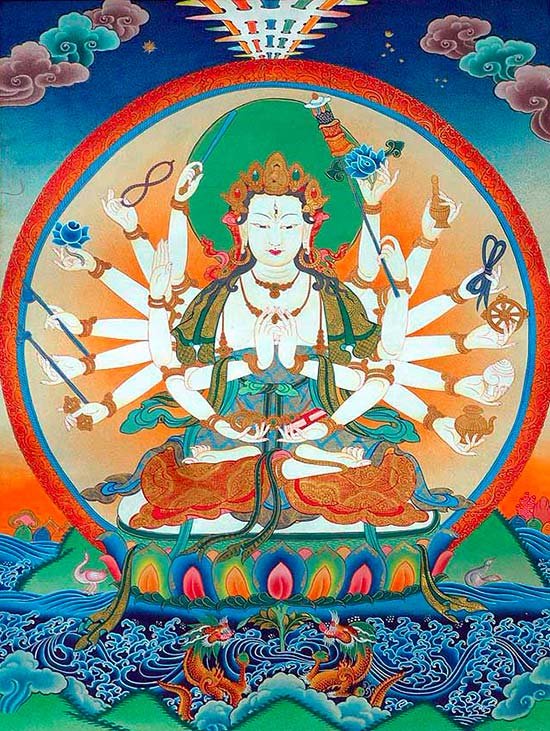Maha Prajnaparamita Sastra
by Gelongma Karma Migme Chödrön | 2001 | 941,039 words
This page describes “seeing the fields of the buddhas of the three times” as written by Nagarjuna in his Maha-prajnaparamita-sastra (lit. “the treatise on the great virtue of wisdom”) in the 2nd century. This book, written in five volumes, represents an encyclopedia on Buddhism as well as a commentary on the Pancavimsatisahasrika Prajnaparamita.
Part 1 - Seeing the fields of the Buddhas of the three times
Sūtra (cf. Pañcaviṃśati, p. 39, l. 17–18; Śatasāhasrikā, p. 100, l. 5–8). – Furthermore, O Śāriputra, the bodhisattva-mahāsattva must practice the perfection of wisdom if he wishes to see the Buddha-fields of the past and future Buddhas, and if he wishes to see the Buddha-fields of the Buddhas existing at the present everywhere in the ten directions (Punar aparaṃ, Śāriputra, bodhisattvena mahāsattvena atītanāṃ cānāgatānāṃ ca buddhānāṃ bhagavatāṃ buddhakṣetrāṇi draṣṭukāmena, pratyutpannānām api samantād daśadikṣu buddhānāṃ bhagavatāṃ buddhakṣetrāṇi draṣṭukāmena prajñāpāramitāyāṃ śikṣitavyam).
Śāstra. –
Question. – But in seeing the Buddhas of the ten directions (cf. p. 2272F) the bodhisattva has already seen their Buddha-fields; why speak again here of the bodhisattva “who wishes to see the Buddha-fields”?
Answer. – [Above], the bodhisattva had not yet penetrated deeply into the dhyānas and the absorptions (samāpatti) and, had he seen the Buddha-fields of the ten directions with their mountains, rivers, plants and trees, his mind would have been distracted (vikṣipta): this is why he was limited to seeing the Buddhas. Everything happened as in the recollection of the Buddha (buddhānusmṛti) where it is said (p. 1340F) that “the yogin sees only the Buddhas but does not see the lands, the mountain, the rivers or the trees”. Here, on the other hand, the bodhisattva has obtained the power of the dhyānas and the absorptions (samāpatti) and is thus able to see as much as he wants (yatheccham), [not only the Buddhas but also the Buddha-fields].
Furthermore, the very pure Buddha-fields (pariśuddhabuddhakṣetra) are difficult to see: this is why the Prajñāpāramitā says here that “if he wishes to see the Buddha-fields, the bodhisattva must practice the perfection of wisdom.” [306c]
Finally, each Buddha possesses hundreds of thousands of kinds of buddhakṣetras. As I said before (p. 2230F), there are pure (viśuddha), impure (aviśuddha), mixed (miśra) or absolutely pure (atyantapariśuddha) buddhakṣetras: since the latter are hard to see (durdṛśa), the power of the Prajñāpāramitā is needed to discover them. It is like the devaputra:[1] in his audience hall; he can be seen by the people from the outside, but in his private apartments he is not seen by anyone.
Question. – We accept that the buddhakṣetras presently existing in the ten directions can be seen; but how could one see the buddhakṣetras of the past and future Buddhas?
Answer. – The bodhisattva possesses the concentration called ‘vision of the past and future’ (atītānāgatadarśana); in this concentration he sees things past and future: it is like the visions in a dream (svapnadarśana).
Furthermore, the bodhisattva possesses the concentration of unceasing term (anirodhakoṭi).[2] In this concentration, he does not see that the Buddhas have cessation.
Question. – But these two concentrations (samādhi) are not of the eyes (cakṣus); then how could he see?
Answer. – These two concentrations are wisdoms (prajñā) metaphorically (prajñaptitas) called ‘eye’. Similarly, in the [triple] turning (parivarta) of the Wheel of Dharma (dharmacakra), on [each of the twelve aspects (ākāra) of the four noble truths (āryasatya), the ascetic obtains the ‘eye’ (cakṣus), the knowledge (jñāna), the clear intuition (vidyā), the awareness (buddhi).[3]
Furthermore, the bodhisattva who sees the buddhakṣetras presently existing in the ten directions knows perfectly well that the past (atīta) and future (anāgata) buddhakṣetras are the same as them. Why? Because the qualities (guṇa) of the Buddhas are the same amongst all of them. In this regard, see p. 2228F.
Finally, in [the view] of the prajñāpāramitā, the present (pratyutpanna), the past (atīta) and the future (anāgata) are the same (sama) and without differences (nirviśiṣṭa) for it is a matter of one and the same suchness (tathatā), one and the same fundamental element (dharmadhātu). This is why you should not argue with us here.
Footnotes and references:
[1]:
Under the official title of devaputra, the Traité here means the Kuṣāṇa emperor ruling at its time: cf. Traité, Vol. III, Introduction, p. XI.
[2]:
The anirodhakoṭi, like the anutpādakoṭi mentioned above (Pañcaviṃśati, p. 29, l. 7) is none other than the true nature of dharmas without production or cessation.
[3]:
The bodhisattva sees the true nature of things by means of pure wisdom (prajñā anāsrava) and, even in the earliest texts, this wisdom which in reality sees nothing, is metaphorically called ‘eye’ (cakṣus).
